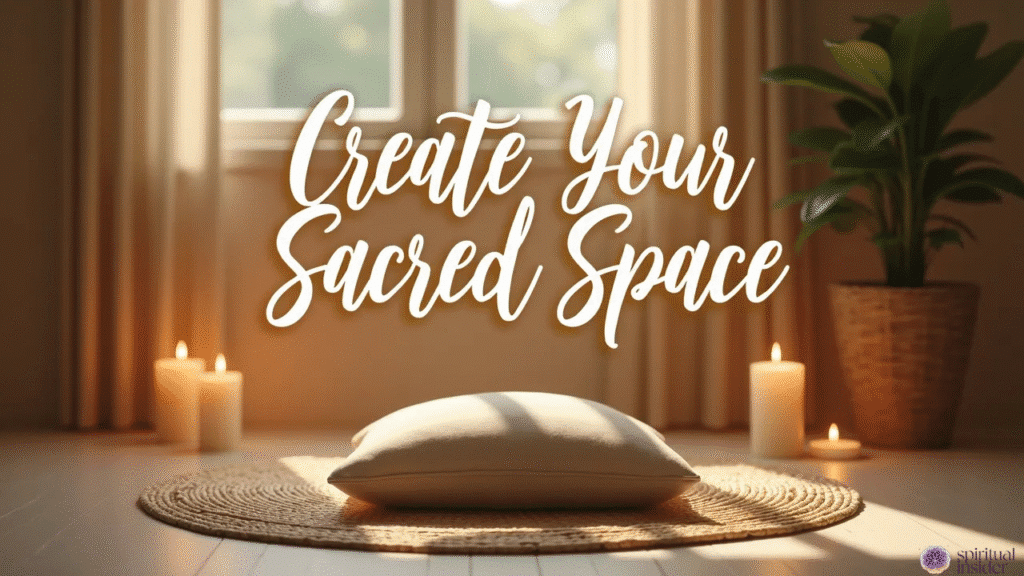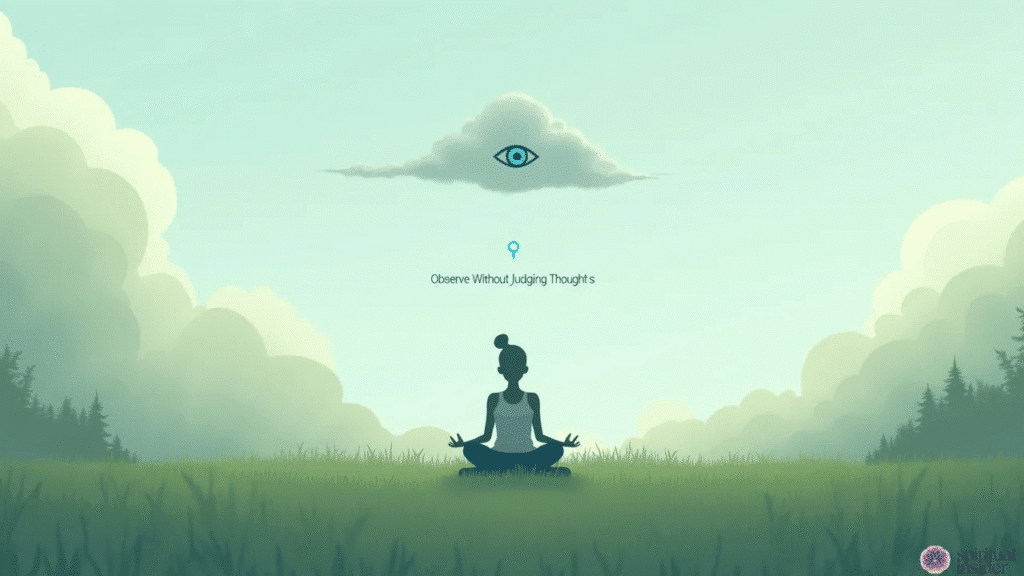Guided meditation on acceptance transforms how we relate to life’s inevitable challenges. This powerful practice doesn’t ask you to like everything that happens, but rather to stop fighting reality and find peace within whatever arises.
Guided meditation on acceptance helps you find inner peace by learning to stop fighting reality. It teaches you to observe your thoughts and feelings without judgment, embracing the present moment and cultivating self-compassion.
Why Acceptance Changes Everything
Acceptance meditation breaks the cycle of suffering that comes from resisting what we cannot change. When we fight against difficult emotions or circumstances, we actually amplify our pain and create additional layers of stress.

The paradox of acceptance reveals itself through practice. By surrendering our need to control outcomes, we discover genuine freedom and inner strength that no external circumstance can shake.
| Resistance vs Acceptance | Typical Response | Acceptance Response |
|---|---|---|
| 😤 Traffic jam | Anger, frustration | 😌 Use time for breathing |
| 💔 Relationship ending | Denial, bargaining | 🤗 Allow grief process |
| 🏥 Health diagnosis | Panic, despair | 💪 Focus on what’s controllable |
| 📉 Job loss | Shame, blame | 🌱 Explore new opportunities |
| 🌧️ Bad weather | Irritation, complaining | ☂️ Adapt plans peacefully |
| 💸 Financial setback | Anxiety, worry | 📝 Create practical solutions |
| 🗣️ Criticism from others | Defensiveness, anger | 🎯 Extract useful feedback |
| ⏰ Aging process | Fear, resistance | 🌅 Embrace life’s seasons |
The Scientific Foundation of Acceptance Meditation
Neuroplasticity research shows that acceptance meditation literally rewires our brains. Regular practice strengthens the prefrontal cortex while calming the amygdala’s fight-or-flight responses.
Studies from Harvard Medical School demonstrate that acceptance-based meditation reduces cortisol levels by up to 23% within eight weeks. This dramatic stress hormone reduction translates into better sleep, improved immune function, and enhanced emotional regulation.
The Default Mode Network, responsible for self-referential thinking and rumination, becomes less active during acceptance practices. This creates space for present-moment awareness and reduces the mental chatter that fuels anxiety and depression.
Clinical research on Acceptance and Commitment Therapy shows significant improvements in psychological flexibility. Participants who practice acceptance meditation report 40% less emotional reactivity and 35% better stress management compared to control groups.
Preparing for Your Meditation Practice
Creating your sacred space doesn’t require elaborate setup. A quiet corner with minimal distractions works perfectly for developing your acceptance meditation practice.

Comfortable clothing and proper posture support deeper states of relaxation. Sit with your spine naturally straight, shoulders relaxed, and hands resting gently on your knees or in your lap.
| Meditation Environment Setup | Essential Elements | Optional Enhancements |
|---|---|---|
| 🪑 Seating | Cushion or chair | 🕯️ Candles |
| 🔇 Sound | Quiet space | 🎵 Soft music |
| 🌡️ Temperature | Comfortable warmth | 🌿 Plants |
| 📱 Distractions | Phone off/away | 🧘 Meditation bell |
| 👕 Clothing | Loose, comfortable | 🧸 Comfort object |
| ⏰ Timing | 10-20 minutes | 📅 Consistent schedule |
| 💡 Lighting | Soft, natural | 🌅 Natural light |
| 🧘 Position | Upright, relaxed | 🛏️ Blanket nearby |
Setting realistic expectations prevents frustration and supports consistent practice. Your mind will wander frequently during guided meditation for acceptance, and that’s completely normal rather than a sign of failure.
If you’re interested, check out: Are Deer A Sign Of Angels?
Grounding Yourself in the Present Moment
Present moment awareness forms the foundation of all acceptance meditation. Your breath serves as a constant anchor, always available to bring you back to the here and now.
The 5-4-3-2-1 technique grounds you quickly when anxiety arises. Notice five things you can see, four you can touch, three you can hear, two you can smell, and one you can taste.
Body sensations offer another pathway to present-moment awareness. Feel your feet on the floor, your back against the chair, or the air moving in and out of your nostrils.
Mental time travel into past regrets or future anxieties pulls us away from acceptance. Gentle redirection back to immediate sensory experience anchors you in the only moment where peace truly exists.
Observing Without Judgment
Neutral awareness transforms your relationship with difficult thoughts and emotions. Instead of immediately reacting or trying to change what arises, you simply notice with curiosity and compassion.

The witness consciousness meditation teaches you to observe your mental activity without getting caught up in its content. You become the calm observer rather than the anxious participant in your own mental drama.
| Judgment Patterns | Judgmental Thought | Neutral Observation |
|---|---|---|
| 😡 About emotions | “I shouldn’t feel angry” | 🔍 “Anger is present” |
| 🧠 About thoughts | “This thought is terrible” | 👁️ “Thinking is happening” |
| 💭 About mind wandering | “I’m bad at meditation” | 🌊 “Mind naturally wanders” |
| 😰 About anxiety | “I’m too anxious” | 📊 “Anxiety level is high” |
| 😢 About sadness | “I should be over this” | 💧 “Sadness is here now” |
| 🤯 About overwhelm | “I can’t handle this” | 🌪️ “Overwhelm is intense” |
| 😴 About tiredness | “I’m so lazy” | 🛌 “Body needs rest” |
| 🤔 About confusion | “I’m stupid” | 🧩 “Clarity isn’t present” |
Common judgment traps include labeling emotions as “good” or “bad” rather than simply information. The noting technique helps you recognize these patterns by silently naming what you notice: “judging,” “planning,” “worrying,” or “remembering.”
You may also like to read: Spiritual Meaning of a Deer in Your Path
Embracing Your Entire Emotional Spectrum
Emotional intelligence develops through welcoming all feelings rather than pushing away uncomfortable ones. Every emotion carries valuable information about your needs, values, and boundaries.
The RAIN technique provides a structured approach to difficult emotions. Recognize what you’re feeling, Allow it to be present, Investigate with kindness, and Nurture yourself through the experience.
Anger often masks hurt or fear underneath its fiery surface. Sadness signals loss or unmet needs that require attention and care.
Fear alerts you to potential threats, both real and imagined. Shame points to areas needing compassion and healing rather than harsh self-criticism.
| Emotional Intelligence Map | Surface Emotion | Deeper Message |
|---|---|---|
| 😤 Anger | Frustration, rage | 💔 Hurt or boundary violation |
| 😢 Sadness | Depression, grief | 🤗 Need for comfort |
| 😨 Fear | Anxiety, worry | 🛡️ Desire for safety |
| 😳 Shame | Embarrassment, guilt | 💝 Need for acceptance |
| 😔 Loneliness | Isolation, emptiness | 🤝 Craving connection |
| 🤯 Overwhelm | Stress, chaos | 🧘 Need for simplicity |
| 😒 Boredom | Apathy, restlessness | 🎯 Seeking purpose |
| 😤 Resentment | Bitterness, grudge | ⚖️ Desire for justice |
Cultivating Self-Compassion
Self-compassion forms the heart of acceptance meditation. Dr. Kristin Neff’s research identifies three essential components: self-kindness, common humanity, and mindful awareness.
Loving-kindness meditation for yourself begins with placing a hand on your heart and offering yourself the same gentleness you’d give a good friend. Repeat phrases like “May I be happy, may I be peaceful, may I be kind to myself.”

Your inner critic often speaks louder than your wise, compassionate voice. Guided meditation for self-acceptance helps you recognize this harsh internal dialogue and respond with understanding rather than agreement.
Forgiveness practices for past mistakes don’t excuse harmful behavior but free you from carrying unnecessary guilt. Self-forgiveness becomes possible when you recognize that everyone makes mistakes while learning and growing.
| Self-Compassion Practices | Harsh Inner Voice | Compassionate Response |
|---|---|---|
| 🤗 Mistakes | “I’m such an idiot” | 💝 “Everyone makes mistakes” |
| 😔 Setbacks | “I’m a failure” | 🌱 “This is part of learning” |
| 🏃 Perfectionism | “It’s not good enough” | ✨ “I did my best today” |
| 💪 Weakness | “I should be stronger” | 🤲 “It’s okay to need help” |
| 🎯 Goals | “I’ll never achieve this” | 🚶 “Progress happens gradually” |
| 👥 Comparison | “Everyone else has it easier” | 🌍 “We all struggle sometimes” |
| 🎭 Authenticity | “I’m not being real” | 🌈 “I’m learning who I am” |
| ⏰ Timing | “I’m behind in life” | 🕰️ “Everyone has their own pace” |
You might find this interesting: 17 Headache Meaning Spiritual
Accepting Life’s Unchangeable Realities
Radical acceptance doesn’t mean passive resignation to unfair circumstances. It means acknowledging reality clearly so you can respond wisely rather than react emotionally to circumstances beyond your control.
The serenity prayer captures this wisdom perfectly: “Grant me the serenity to accept the things I cannot change, courage to change the things I can, and wisdom to know the difference.”
Chronic illness, loss of loved ones, aging, and other life transitions require deep acceptance practices. Fighting these realities only increases suffering without changing the underlying situation.
Grief becomes a pathway to acceptance when we allow ourselves to feel the full weight of loss. This emotional processing, though painful, ultimately leads to healing and integration rather than prolonged suffering.
| Changeable vs Unchangeable | Cannot Change | Can Change |
|---|---|---|
| 🌍 External events | Others’ actions | 🎯 Your response |
| 🧬 Genetics | Physical traits | 💪 Health habits |
| ⏰ Past events | What happened | 🔄 Current choices |
| 👥 Other people | Their behavior | 🚪 Your boundaries |
| 🏛️ Societal systems | Institutions | 🗳️ Your participation |
| 🌦️ Weather | Climate conditions | 🏠 Your preparation |
| ⚰️ Death | Life’s end | 🌱 How you live |
| 🎂 Aging | Time passing | 🧘 Your attitude |
Integrating Acceptance into Daily Life
Micro-meditations throughout your day reinforce acceptance practices. Take three conscious breaths before difficult conversations or when stress begins building.
Morning reflection sets an accepting tone for the entire day. Spend five minutes acknowledging whatever emotions or challenges you’re facing without trying to fix or change them immediately.
Workplace acceptance practices transform professional stress. When criticism arises, pause and breathe before responding automatically with defensiveness or anger.
Relationship dynamics improve dramatically when you practice acceptance of others’ personalities and behaviors. This doesn’t mean tolerating abuse, but rather responding thoughtfully instead of reactively to everyday conflicts.
| Daily Integration Techniques | Situation | Acceptance Practice |
|---|---|---|
| 🌅 Morning routine | Waking up | 🧘 Three mindful breaths |
| 🚗 Commuting | Traffic stress | 📻 Accepting what is |
| 💼 Work pressure | Deadline anxiety | ⏸️ Pause and breathe |
| 🏠 Family dynamics | Conflict arising | 👂 Listen without fixing |
| 🛒 Daily errands | Long lines | 🎵 Use waiting mindfully |
| 🌙 Evening wind-down | Day’s challenges | 📝 Journal acceptance |
| 🛏️ Bedtime | Racing thoughts | 🌊 Let thoughts flow |
Continue on your article: 17 Sweet Pink Bird Spiritual Meaning
Spiritual Meanings of Acceptance
The Sacred Surrender represents acceptance as divine trust in life’s unfolding. When we stop fighting the river of existence, we discover we’re already being carried toward our highest good and deepest learning.
This spiritual dimension transforms meditation from mere stress relief into sacred practice. Ancient traditions teach that true acceptance connects us to universal flow, what Taoists call wu wei or effortless action.

Unity Consciousness reveals how personal struggles mirror universal human experience. Through deep acceptance meditation, we recognize our individual healing as part of collective awakening and shared wisdom.
This recognition dissolves the ego’s story of being uniquely wronged or blessed. We begin accepting not just our own experience but recognizing it as part of the greater tapestry of existence.
| Spiritual Dimensions | Personal Level | Universal Level |
|---|---|---|
| 🙏 Sacred surrender | Trusting life’s flow | 🌌 Divine guidance |
| 🕊️ Inner peace | Personal healing | 🌍 World peace |
| 💫 Unity awareness | Self-acceptance | 🤝 Human connection |
| 🌱 Growth through pain | Learning from struggle | 🌳 Collective wisdom |
| 🌊 Going with flow | Releasing control | 🌀 Natural order |
| 🔄 Cycles of change | Personal transitions | 🌙 Universal rhythms |
| 💎 Finding purpose | Individual calling | 🌟 Cosmic purpose |
Your Ongoing Journey of Acceptance
Progress in acceptance meditation isn’t linear, and that’s perfectly normal. Some days you’ll feel centered and peaceful, while others might bring intense resistance or emotional turbulence.
Building your personal acceptance toolkit takes time and consistent practice. Start with short sessions and gradually extend your meditation periods as comfort and familiarity develop.
Remember that acceptance doesn’t mean becoming passive or giving up on positive change. True acceptance actually empowers more effective action by reducing the emotional reactivity that clouds clear thinking and wise decision-making.
The ripple effect of your inner peace extends far beyond personal benefits. As you develop greater acceptance and emotional balance, you naturally contribute to more harmonious relationships and a more peaceful world around you.

Stella Henry is a dedicated spiritual researcher and expert blogger with over a decade of experience exploring metaphysical phenomena and consciousness. As a gifted intuitive and meditation practitioner, she brings profound insights to My Spiritual Insider through her well-researched articles on spiritual meanings, awakening, symbolism, and universal wisdom.







